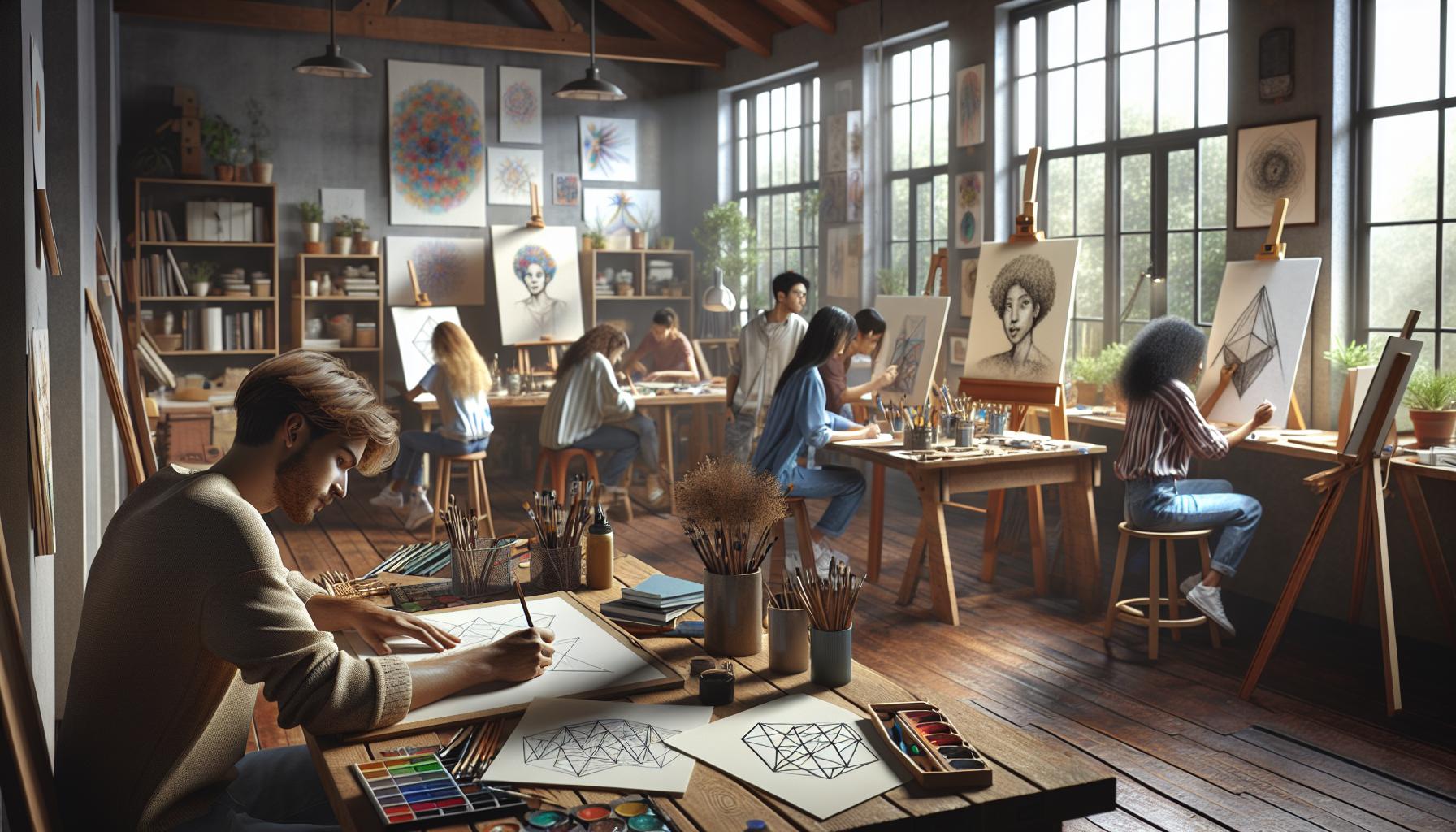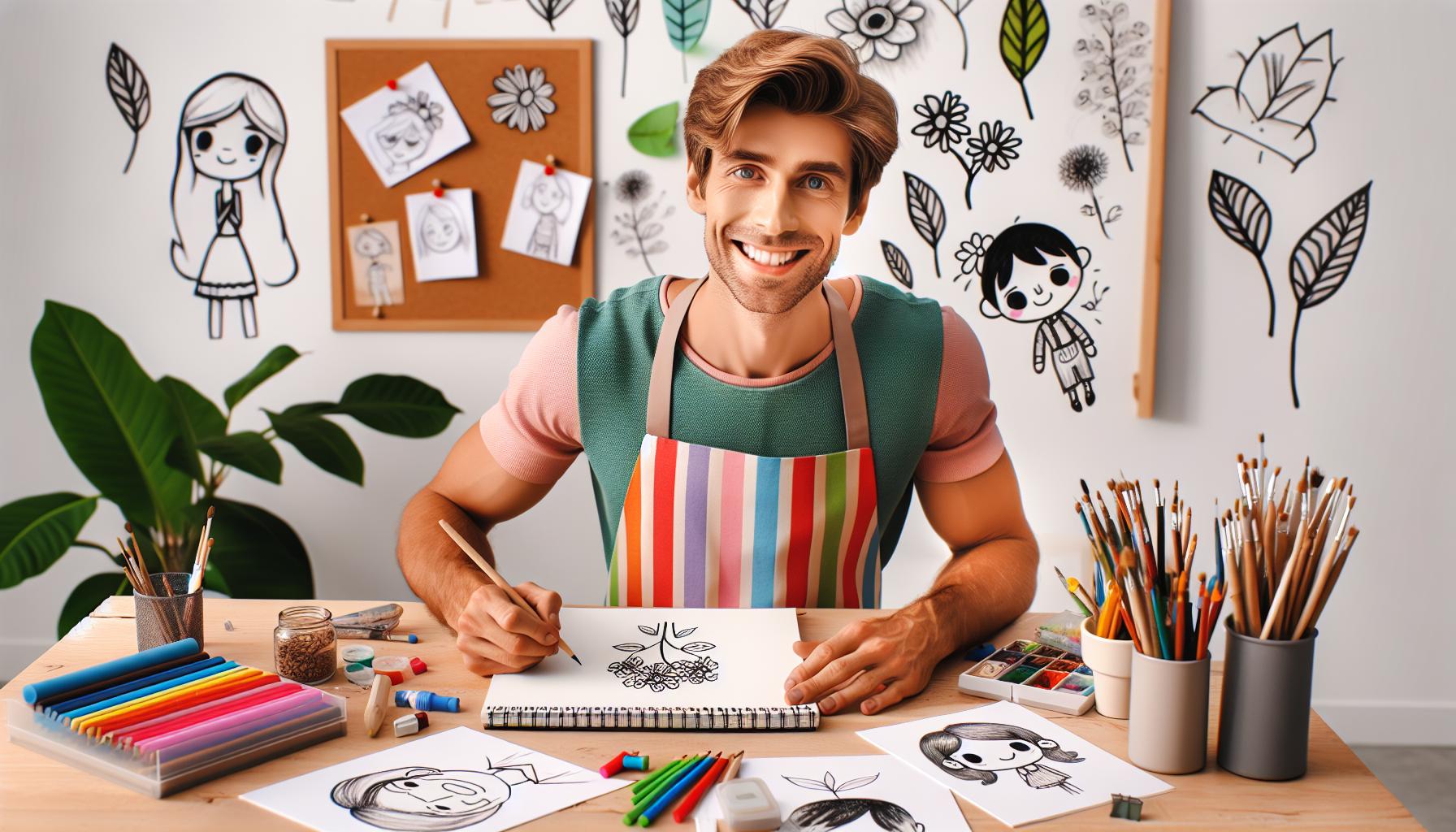Drawing cool artwork doesn’t have to be complicated. In fact, creating “dibujos chidos” (awesome drawings) can be surprisingly simple with the right techniques and approach. Whether someone’s a beginner or looking to enhance their artistic skills, these easy-to-follow methods can help unlock their creative potential.
From quirky cartoon characters to eye-catching graffiti styles, the world of “dibujos chidos” offers endless possibilities for self-expression. Today’s artists are discovering that even basic shapes and lines can transform into stunning artwork that captures attention and sparks imagination. It’s all about starting with simple concepts and building confidence one stroke at a time.
Faciles:rxoq9rtb1u4= Dibujos Chidos
Simple cool drawings combine basic geometric shapes with creative elements to produce visually striking artwork. These drawings incorporate fundamental patterns like circles squares triangles that transform into expressive characters objects scenes.
Popular simple cool drawing styles include:
- Bubble letters with 3D effects shadowing
- Cartoon characters featuring exaggerated features expressions
- Geometric animals made from basic shapes patterns
- Abstract doodles using repetitive lines curves
- Minimalist face profiles using continuous lines
- Graffiti-style text with creative embellishments
Key characteristics of simple cool drawings:
- Clean defined lines without complex shading
- Limited color palettes focusing on bold contrasts
- Recognizable subjects with stylized elements
- Basic shapes arranged in unexpected ways
- Repeating patterns creating visual interest
- Strategic use of negative space
The most engaging simple drawings often feature:
| Element | Purpose | Visual Impact |
|---|---|---|
| Bold outlines | Define shapes | Creates clarity |
| Pattern fills | Add texture | Increases depth |
| Simple shadows | Create dimension | Adds realism |
| Symmetry | Balance design | Attracts attention |
| Contrast | Focus interest | Enhances appeal |
These drawings integrate essential artistic principles while maintaining accessibility for artists at any skill level. The combination of basic techniques with creative interpretation produces artwork that captures attention through its straightforward yet impactful design elements.
Essential Tools and Materials

Creating impressive artwork requires a core set of reliable tools alongside optional materials that enhance creative possibilities. The right supplies enable artists to experiment with various techniques while maintaining consistent quality.
Basic Drawing Supplies
A quality sketchbook with medium-weight paper forms the foundation for cool drawings. Standard graphite pencils in HB 2B 4B grades provide versatile line control. Black fine-liner pens (0.3mm 0.5mm 0.8mm) deliver crisp outlines for dynamic artwork. A reliable pencil sharpener maintains precise tips. Erasers in both rubber kneaded varieties remove mistakes cleanly. A ruler helps create straight edges geometric shapes. A drawing board supports proper working posture technique.
| Essential Supply | Purpose |
|---|---|
| Sketchbook | Drawing surface stability |
| Graphite Pencils | Initial sketching shading |
| Fine-liner Pens | Clean outlines detailing |
| Erasers | Mistake correction |
| Ruler | Precise measurements |
Optional Art Materials
Colored markers add vibrant elements to finished pieces. Brush pens create dynamic line variations thickness. Watercolor pencils blend smoothly for subtle color transitions. White gel pens highlight details on dark backgrounds. Metallic markers produce eye-catching accents effects. Blending stumps smooth graphite shading gradients. Templates assist with complex shapes patterns. Spray fixative protects completed artwork from smudging.
| Optional Supply | Enhancement |
|---|---|
| Markers | Color variety |
| Brush Pens | Line dynamics |
| Gel Pens | Detail work |
| Templates | Shape accuracy |
| Fixative | Work protection |
Step-by-Step Drawing Techniques

Creating impressive artwork starts with mastering fundamental drawing techniques. These methods build confidence through systematic practice while developing essential artistic skills.
Basic Shapes and Forms
Basic geometric shapes form the foundation of any cool drawing. Artists begin with circles, squares, triangles positioned strategically on the paper. Breaking down complex subjects into simple shapes makes drawing manageable – a face becomes a circle with oval eyes a triangular nose rectangular mouth. Combining shapes creates more intricate forms – cylinders from rectangles circles spheres from overlapping circles. Adding curved lines connects shapes smoothly transforming basic geometry into dynamic artwork. Practice exercises include:
- Drawing perfect circles in different sizes
- Creating 3D cubes from squares
- Transforming basic shapes into everyday objects
- Sketching symmetrical patterns using shape repetition
- Building character designs from geometric forms
Shading Methods
Shading adds depth dimension texture to artwork through strategic light dark contrast. Artists use five core techniques:
- Hatching: Single direction parallel lines create uniform shadows
- Cross-hatching: Overlapping lines at angles produce darker values
- Circular shading: Small circular motions blend smoothly
- Stippling: Clusters of dots generate textured shadows
- Gradient shading: Gradual light to dark transitions
Light source direction determines shadow placement intensity. Hard edges indicate sharp contrast while soft edges show gradual transitions. Building layers slowly allows better control over value ranges. Starting with light pressure increases gradually creates smoother shading results.
Popular Easy Drawing Ideas

Easy drawing ideas transform simple concepts into engaging artwork through basic techniques and creative elements. These popular designs appeal to artists of all skill levels while producing visually striking results.
Nature-Inspired Designs
Nature-inspired drawings capture organic elements through simplified shapes and patterns. Artists create leaves using curved lines and basic geometric forms to establish recognizable silhouettes. Trees emerge from combinations of circles and triangles, with textural details added through strategic line work. Mountains take shape through angular forms and parallel lines to convey depth. Flowers bloom from circle centers with symmetrical petals radiating outward. Cloud formations develop from connected curved shapes, while waves flow through repeating curved lines. These natural subjects incorporate organic textures through dots, dashes and crosshatching patterns.
Cartoon Characters
Cartoon characters start with basic circular shapes for heads and rectangular bodies. Large expressive eyes dominate facial features, taking up one-third of the face space. Round button noses sit centered below eye level. Mouths range from simple curved lines to exaggerated expressions showing emotions. Arms bend at right angles using cylinder shapes for natural movement. Legs extend from rectangular torsos using basic geometric forms. Hair styles utilize flowing curved lines or spiky angular shapes. Clothing details emerge through simple folds indicated by curved parallel lines. These simplified features create recognizable characters while maintaining an approachable drawing style.
Tips for Improving Your Skills
Practicing daily sketching exercises develops muscle memory for smoother line work. Artists benefit from dedicating 15 minutes each morning to warm-up sketches focusing on basic shapes circles squares triangles.
Regular experimentation with different art styles expands creative range:
- Mix cartoon elements with realistic details
- Combine geometric patterns with organic shapes
- Integrate graffiti techniques into traditional drawings
- Blend minimalist designs with complex textures
Reference gathering enhances artistic growth through structured observation:
- Create inspiration boards with favorite artworks
- Study shapes patterns textures in nature
- Photograph interesting subjects for later practice
- Analyze professional artists’ techniques
Technical skill development requires focused practice sessions:
- Master smooth curved lines through repetitive exercises
- Perfect pressure control using varying pencil grades
- Practice consistent hatching patterns at different angles
- Develop precise proportion skills using measurement tools
Time management strategies optimize practice effectiveness:
- Set 30-minute focused drawing sessions
- Break complex projects into manageable segments
- Rotate between different techniques each practice day
- Schedule regular skill assessment reviews
Digital resources supplement traditional learning methods:
- Follow step-by-step online tutorials
- Join virtual drawing challenges
- Participate in art community forums
- Watch technique demonstration videos
These targeted improvement strategies build upon the previously discussed fundamentals while expanding artistic capabilities. Each approach reinforces core skills through systematic practice deliberate experimentation.
Common Mistakes to Avoid
Pressing too hard with drawing tools creates permanent indentations in the paper, making erasing difficult. Light, controlled strokes allow for easier corrections and smoother line work.
Incorrect proportions distort artwork balance, particularly in facial features or body parts. Starting with basic geometric guidelines ensures proper size relationships between elements.
Rushing through details leads to inconsistent line quality and uneven shading. Taking time to plan composition elements produces cleaner, more professional results.
Poor paper quality causes smudging and restricts certain techniques. Using appropriate paper weight for specific mediums prevents bleeding and maintains crisp lines.
These common drawing pitfalls affect artwork quality:
- Skipping preliminary sketches before final drawing
- Adding shadows without identifying light source
- Using inconsistent line weights throughout the piece
- Overworking areas instead of maintaining simplicity
- Ignoring negative space in composition
- Mixing incompatible drawing materials
Ignoring basic shape construction results in disproportionate drawings. Breaking down complex subjects into simple forms improves accuracy.
Improper tool maintenance reduces drawing quality:
- Dull pencils creating fuzzy lines
- Dirty erasers spreading graphite
- Dried markers producing streaky results
- Contaminated pens causing ink blotches
Incorrect grip positions create hand fatigue and reduce line control. Holding drawing tools 1-2 inches from the tip provides optimal stability and movement range.
Inadequate lighting casts misleading shadows on the drawing surface. Positioning light sources at 45-degree angles minimizes glare and shadow interference.
Creating cool drawings isn’t about natural talent – it’s about dedication practice and the right approach. Artists who master basic shapes develop proper techniques and maintain quality tools will see their artwork flourish. By starting simple and gradually building complexity anyone can create impressive “dibujos chidos” that capture attention and express creativity.
The journey to artistic excellence continues with each stroke of the pencil. As skills develop through consistent practice artists unlock new possibilities in their creative expression. With these fundamental techniques and strategies success in creating eye-catching artwork is within everyone’s reach.

